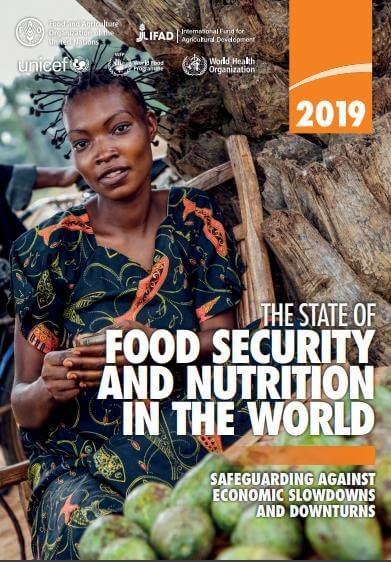- Share this article
- Subscribe to our newsletter
The State of Food Security and Nutrition in the World 2019
The latest edition of The State of Food Security and Nutrition in the World report was released by the United Nations' Food and Agriculture Organization (FAO), the International Fund for Agricultural Development (IFAD), the UN Children's Fund (UNICEF), the World Food Programme (WFP) and the World Health Organization (WHO) in mid-July 2019. This year's report focuses on the role of economic slowdowns and downturns in food security and nutrition.
The report finds that the number of hungry people is still increasing, with an estimated 820 million not having enough to eat in 2018, up from 811 million in the previous year. Most alarming is the situation in Africa, the region with the highest rates of hunger in the world and that are continuing to slowly but steadily rise in almost all subregions.
Together, Africa and Asia bear the greatest share of all forms of malnutrition, accounting for more than nine out of ten of all stunted children and over nine out of ten of all wasted children worldwide. In southern Asia and sub-Saharan Africa, one child in three is stunted.
A new indicator for measuring food insecurity
This year's report introduces a new indicator for measuring food insecurity at different levels of severity and monitoring progress towards SDG 2: the prevalence of moderate or severe food insecurity. This indicator is based on data obtained directly from people in surveys about their access to food in the last 12 months, using the Food Insecurity Experience Scale (FIES). People experiencing moderate food insecurity face uncertainties about their ability to obtain food and have had to reduce the quality and/or quantity of food they eat to get by.
The report estimates that over 2 billion people, mostly in low- and middle-income countries, do not have regular access to safe, nutritious and sufficient food. But irregular access is also a challenge for high-income countries, including 8 per cent of the population in Northern America and Europe. This calls for a profound transformation of food systems to provide sustainably produced healthy diets for a growing world population, the authors say.
(FAO/IFAD/UNICEF/WFP/WHO/ile)
More information:
Download The State of Food Security and Nutrition in the World report
Article about a GIZ project in Mali using the new indicator FIES





Add a comment
Be the First to Comment